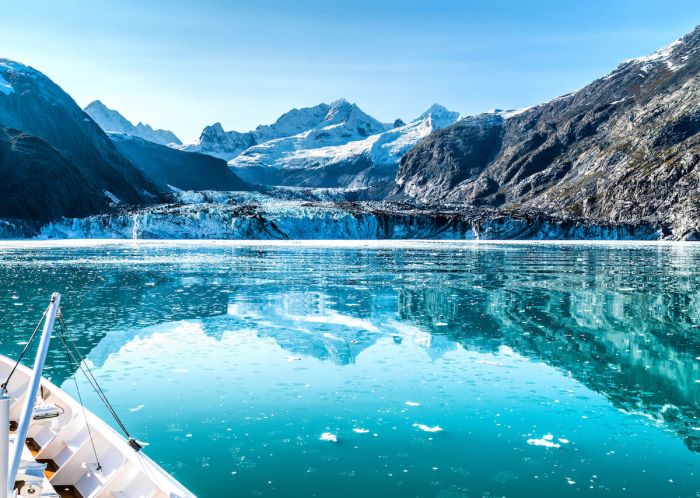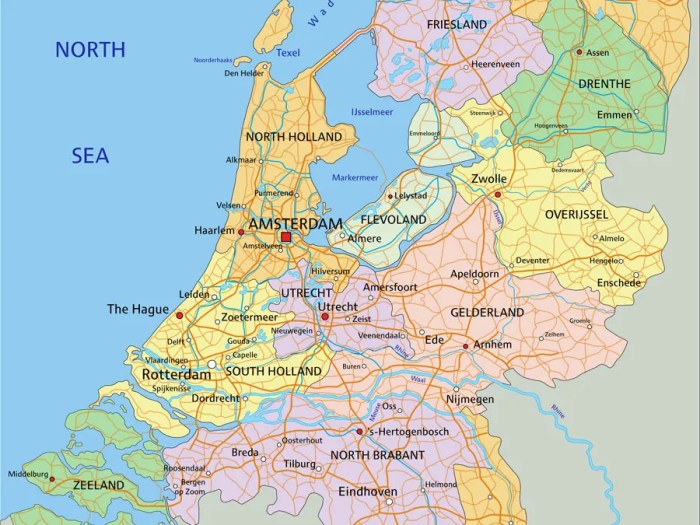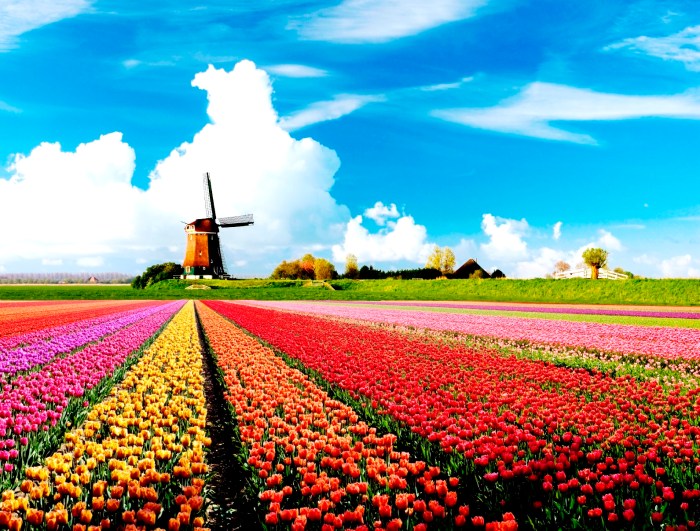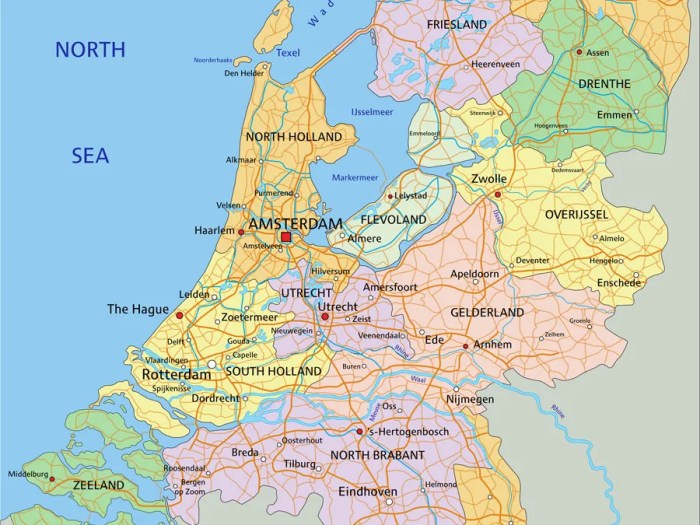Alaska Earth Water Sky: A journey through the breathtaking landscapes and profound cultural significance of Alaska’s natural elements. This exploration delves into the unique characteristics of the land, water, sky, and earth, revealing their intricate interconnectivity and impact on Alaskan life, from Indigenous traditions to modern-day ecosystems.
From the towering mountains and vast glaciers to the icy rivers and sparkling seas, Alaska’s natural world offers a stunning diversity. We’ll explore the role of these elements in shaping human activities, wildlife populations, and the rich tapestry of Alaskan culture, history, and ecological interactions. The influence of climate change and human impact on this unique environment will also be examined, alongside the enduring efforts of conservation and exploration.
Alaska’s Natural Elements
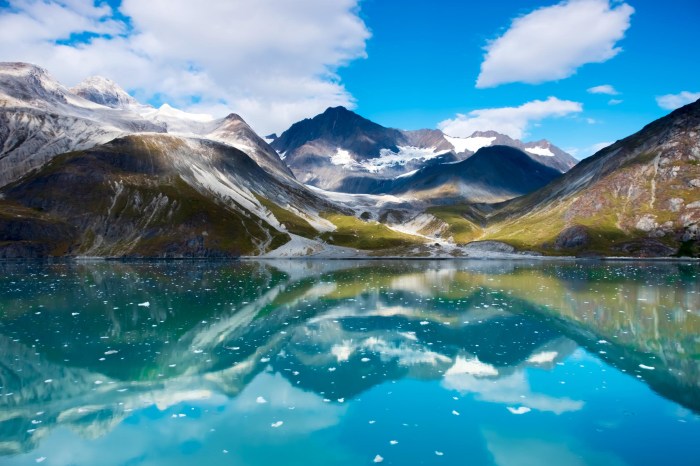
Alaska, a land of breathtaking contrasts, showcases a unique interplay of land, water, sky, and earth. Its vastness and isolation have fostered a powerful ecosystem, shaping both the human and animal life that thrives within its borders. The raw beauty and power of Alaska’s natural elements are a testament to the enduring strength of nature.
Landforms of Alaska
Alaska’s landscape is a mosaic of diverse landforms. From towering mountains, sculpted by glaciers, to vast, flat plains, carved by millennia of erosion, the land reflects a dynamic history. The presence of active volcanoes, like Mount Wrangell, adds a dramatic element to the landscape, a reminder of the geological forces constantly shaping the land. The varied topography of Alaska, including fjords, river valleys, and coastal plains, profoundly influences the distribution of wildlife and human settlements.
Water Bodies in Alaska
Alaska’s water bodies are equally diverse and vital. From the vast expanse of the Arctic Ocean, lapping at the northern shores, to the intricate network of rivers, lakes, and glaciers, water plays a crucial role in the ecosystem. Glacial meltwater feeds rivers and streams, supporting aquatic life and impacting the surrounding environment. The numerous coastal inlets and fjords provide critical habitat for marine mammals and migratory birds.
The unique features of these water bodies, including the presence of ice floes and pack ice, further enrich the Alaskan environment.
Climate Patterns in Alaska
Alaska’s climate is characterized by its wide range of temperatures and precipitation patterns. The region experiences extreme temperature fluctuations, ranging from frigid arctic conditions to milder temperatures in the southern regions. This variation, combined with the influence of ocean currents and prevailing winds, creates diverse microclimates across the state. Precipitation patterns also vary significantly, from heavy snowfall in the mountains to occasional rainfall along the coast.
The impact of climate patterns on the vegetation, wildlife, and human activities in Alaska is profound.
Sky Conditions in Alaska
The Alaskan sky, often vast and expansive, reflects the changing weather patterns. From clear, brilliant skies, ideal for outdoor activities, to overcast conditions, indicative of approaching storms, the sky offers a dynamic display. The aurora borealis, a captivating natural phenomenon, paints the night sky with vibrant colors. The changing light and shadows across the Alaskan landscape, a result of the shifting sun and clouds, create an ever-evolving panorama.
Interconnectivity of Elements
The elements of Alaska are intricately interconnected. For example, glacial meltwater significantly influences the flow of rivers, and the presence of glaciers profoundly impacts the landscape. The unique climate patterns in turn affect both plant and animal life, as well as human activities. This interconnectivity is evident in the diverse ecosystems that thrive in Alaska, from the coastal tundras to the alpine forests.
Comparison with Other Regions
Compared to other regions globally, Alaska’s landscape stands out for its vastness, rugged terrain, and dramatic changes in weather. The sheer scale of Alaska’s mountains, glaciers, and forests is unmatched in many parts of the world. The region’s unique climate patterns, driven by its high latitude and proximity to the ocean, create a distinct environment. The diverse wildlife populations, adapted to the harsh conditions, add to the region’s unique character.
Influence on Human Activities and Wildlife
Alaska’s natural elements profoundly influence human activities. The availability of resources, such as fishing grounds and timber, has historically shaped settlements and industries. The region’s extreme weather conditions and vast distances influence transportation and infrastructure. Wildlife populations, from caribou and bears to whales and seals, are inextricably linked to the availability of food sources and habitat, all influenced by the natural elements.
Alaska’s breathtaking earth, water, and sky always leave me in awe. The sheer immensity of it all is a stark contrast to the rapid urban transformations I’ve witnessed in places like Hong Kong’s Central district. For example, the changing face old Hong Kong central reflects a dynamic interplay of tradition and modernity. Still, the untamed beauty of Alaska’s landscapes remains a constant reminder of nature’s enduring power.
Table of Alaska’s Natural Elements
| Landforms | Water Bodies | Climate Patterns | Sky Conditions |
|---|---|---|---|
| Mountains, glaciers, valleys, plains, fjords, volcanoes | Arctic Ocean, rivers, lakes, glaciers, coastal inlets | Extreme temperature fluctuations, diverse precipitation patterns, microclimates | Clear skies, overcast conditions, aurora borealis |
Cultural and Historical Significance
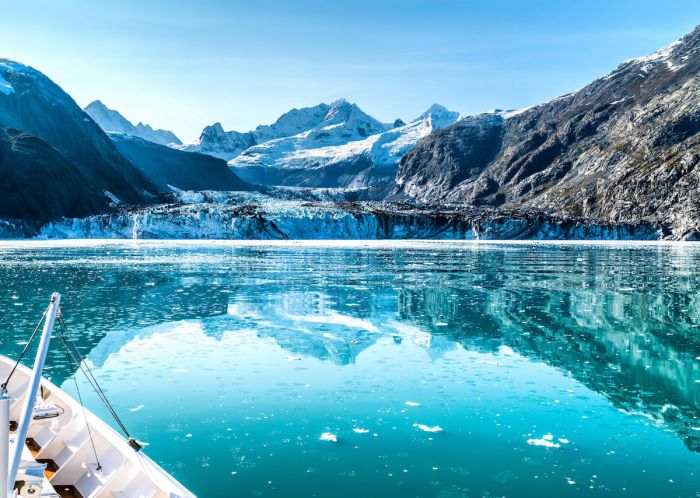
The Alaskan landscape, with its diverse and powerful elements, holds profound cultural and historical significance for Indigenous peoples. Their connection to the land, water, sky, and earth is deeply intertwined with their traditions, stories, and spiritual beliefs. This connection is not merely aesthetic; it is foundational to their identity and way of life. These elements are not viewed as separate entities, but rather as interconnected forces shaping the very fabric of their existence.For millennia, Alaskan Indigenous cultures have developed intricate relationships with their environment.
Their understanding of the natural world is deeply spiritual, often reflected in ceremonies, folklore, and art forms. The elements are not simply observed; they are actively engaged with, understood, and revered.
Historical and Cultural Significance for Alaskan Indigenous Peoples
The profound connection of Alaskan Indigenous peoples with the environment is rooted in their history. For centuries, these communities have relied on the land, sea, and sky for sustenance, shelter, and spiritual guidance. The elements—earth, water, sky, and land—have been integral to their survival and cultural practices. This intimate relationship is woven into their very being, shaping their traditions and beliefs.
Role of Elements in Alaskan Folklore, Traditions, and Ceremonies
The elements are central to Alaskan Indigenous folklore, traditions, and ceremonies. Stories and legends often feature animals, spirits, and natural forces, demonstrating the deep respect and understanding of the interconnectedness of life. Ceremonies and rituals frequently acknowledge the power and influence of these elements. For example, many tribes have ceremonies honouring the salmon run, recognizing the water’s vital role in sustenance.
Similarly, the earth’s bounty is celebrated in harvest festivals, emphasizing the vital role of the land.
Examples of Stories and Legends Related to the Elements
Numerous stories and legends encapsulate the relationship between Alaskan Indigenous peoples and the elements. The creation myths of many tribes describe the Earth’s formation, the emergence of the first people, and the interactions of the natural forces. These stories are not simply tales; they are a profound way of understanding the world and one’s place within it. One such example is the Tlingit legend of the Raven, who played a crucial role in shaping the land and bringing light to the world.
Comparison of Interactions and Valued Aspects of the Alaskan Environment by Different Groups
Different Indigenous groups in Alaska have developed unique perspectives and practices in their interaction with the environment. For instance, the Inupiat, who primarily inhabit the Arctic regions, have developed extensive knowledge of the ice and snow, utilizing it for transportation and hunting. Conversely, the Yup’ik, inhabiting the southern coastal regions, possess extensive knowledge of the sea, relying on the ocean for sustenance and transportation.
These differences reflect the diverse environments and their specific challenges. These varied approaches highlight the deep adaptation and resilience of these cultures.
Symbols and Metaphors Associated with the Elements in Alaskan Culture
The earth, water, sky, and land often serve as powerful symbols and metaphors in Alaskan Indigenous cultures. The mountains, for example, may represent strength and stability, while the vast ocean can symbolize the unknown and the powerful forces of nature. These symbolic representations are central to their understanding of the world and their place within it. Such metaphors appear in art, storytelling, and ceremonial practices, reinforcing their deep connection to the environment.
Reflection of Elements in Alaskan Art, Music, and Literature
| Element | Art | Music | Literature |
|---|---|---|---|
| Earth | Carvings depicting animals and landscapes, often showcasing the intricate details of the Alaskan terrain. | Songs and chants that honour the land and its resources. | Stories emphasizing the significance of the land and the interconnectedness of all living things. |
| Water | Paintings and sculptures representing the sea, rivers, and glaciers, showcasing the powerful forces of nature. | Music and songs narrating the rhythms of the tides and the movement of the water. | Legends and stories that feature animals, spirits, and the significance of the ocean and rivers. |
| Sky | Totem poles often depict animals, spirits, and the sky, representing the forces beyond the physical world. | Musical instruments, like drums, are often used to honour the sky and celestial bodies. | Poems and narratives describing the vastness and power of the sky and its connection to the spiritual world. |
| Land | Weaving, beadwork, and carvings that incorporate elements of the land, such as trees, animals, and natural formations. | Musical pieces that capture the essence of the land, its sounds, and rhythms. | Stories and narratives that tell of the land’s creation, its inhabitants, and its significance to the culture. |
Ecological Interactions: Alaska Earth Water Sky
Alaska’s unique environment, shaped by its vast expanse of land, water, and sky, supports a complex web of ecological interactions. The interplay between these elements is crucial for the survival and flourishing of diverse species, from the smallest insects to the largest mammals. Understanding these interactions is vital for appreciating the fragility and beauty of Alaska’s ecosystems and for developing effective conservation strategies.The delicate balance of Alaska’s ecosystems is constantly being challenged by both natural forces and human activities.
Climate change, for instance, is significantly altering the timing of seasonal events, impacting plant growth, animal migration patterns, and the overall health of the region’s biodiversity. These changes highlight the interconnectedness of the elements and the need for a comprehensive understanding of their relationships.
Relationships Between Elements
The Earth’s topography, from towering mountains to vast plains, dictates the flow of water and the distribution of plant life. Water, in turn, shapes the landscape and provides habitats for aquatic organisms. The sky, with its variations in sunlight and precipitation, directly influences the temperature and growth patterns of plants and animals. These elements are intricately linked, with changes in one often leading to cascading effects on others.
For example, alterations in snowfall patterns can impact the availability of water for streams and rivers, affecting the survival of fish and other aquatic species.
Impact of Climate Change
Climate change is dramatically impacting Alaska’s ecosystems. Rising temperatures are causing permafrost thaw, leading to instability in the landscape and releasing stored carbon into the atmosphere. Warmer temperatures also affect the timing of migrations and breeding cycles for various species, disrupting the delicate balance of predator-prey relationships. Changes in precipitation patterns can lead to increased flooding in some areas and droughts in others, impacting the availability of water and food sources.
Alaska’s breathtaking earth, water, and sky are truly awe-inspiring. Thinking about those vast landscapes makes me crave a cozy escape, maybe a relaxing lounge at a ski lodge airport like ski lodge airport lounge white plains. While I’m daydreaming about the crisp mountain air and panoramic views, I’m still drawn back to the raw beauty of Alaska’s natural elements.
The warming trend is affecting everything from the timing of salmon runs to the distribution of plant species. For instance, the earlier arrival of warmer temperatures has been shown to affect the flowering time of wildflowers, potentially impacting the food sources for pollinators.
Effects of Human Activities
Human activities, including resource extraction, industrial development, and tourism, have significant impacts on Alaska’s natural elements. Oil and gas exploration, for instance, can cause habitat destruction and pollution, impacting the surrounding ecosystems. Construction of infrastructure can fragment habitats, disrupting wildlife movement and gene flow. Increased human presence can also contribute to the spread of invasive species, further disrupting the delicate balance of the ecosystem.
Pollution from human activities, such as air and water pollution, can also negatively impact the overall health of the environment.
Comparison of Ecosystems
Alaska’s diverse ecosystems, ranging from coastal tundras to alpine meadows, support a wide array of species adapted to specific environmental conditions. Coastal ecosystems, characterized by their proximity to the ocean, are influenced by ocean currents and tides, supporting unique communities of marine life. Tundra ecosystems, with their permafrost and low-lying vegetation, are home to hardy species like caribou and musk oxen.
Forests, particularly in the southern regions, offer habitats for a variety of trees, birds, and mammals. These differences in ecosystems highlight the varying interactions between the Earth, water, sky, and land. The presence of these diverse ecosystems showcases the wide range of adaptations that species have developed in response to the varying conditions of Alaska.
Importance of Biodiversity
Biodiversity plays a crucial role in maintaining the balance of Alaska’s ecosystems. A variety of species, each with its unique role in the food web, contributes to the stability and resilience of the environment. The loss of even a single species can have cascading effects on the entire ecosystem, disrupting the delicate balance of interactions between the elements.
A high degree of biodiversity increases the ability of the ecosystem to withstand disturbances like climate change. The presence of diverse plant life, for example, can contribute to better soil stability, and a wide array of animal species can ensure the efficient recycling of nutrients.
Alaskan Ecosystems and Interactions
| Ecosystem | Earth | Water | Sky | Land |
|---|---|---|---|---|
| Coastal Tundra | Flat, rocky terrain; permafrost | Ocean currents, tides, coastal rivers | Variable cloud cover, precipitation | Coastal vegetation, marine life |
| Boreal Forest | Rocky, mountainous terrain; variable soil types | Rivers, lakes, streams | Significant sunlight, precipitation | Trees, shrubs, various wildlife |
| Alpine Meadow | Rocky, mountainous terrain; thin soil | Streams, meltwater | High sunlight intensity, variable precipitation | Alpine plants, grazing animals |
| Arctic Tundra | Flat, rocky terrain; permafrost | Lakes, rivers, streams | Long periods of sunlight in summer, darkness in winter | Low-lying vegetation, migratory birds |
Exploration and Discovery
Unveiling Alaska’s hidden treasures has been a journey marked by intrepid explorers, groundbreaking scientific discoveries, and a growing understanding of the delicate balance within its unique ecosystem. From the earliest encounters to modern-day research, the exploration of Alaska’s natural elements has shaped our understanding of this vast and diverse region. The quest to comprehend its beauty and complexity continues to inspire conservation efforts that protect Alaska’s natural heritage for future generations.The historical exploration of Alaska’s diverse landscapes and resources has been driven by a combination of economic interests, scientific curiosity, and a desire to understand the region’s unique environment.
Exploring the raw beauty of Alaska’s earth, water, and sky is truly breathtaking. The serene focus and mindful rituals of a Japanese tea ceremony in Kyoto, like the ones detailed in this fantastic guide, guide to japanese tea ceremonies kyoto , offer a similar sense of peace and connection with nature. It’s almost as if the quiet contemplation inherent in the tea ceremony mirrors the quiet majesty of Alaska’s vast wilderness.
This exploration has been characterized by significant shifts in understanding, from initial encounters to the development of scientific methodologies for studying Alaska’s intricate ecosystems.
Historical Exploration of Alaska’s Natural Elements
Early encounters with Alaska’s natural elements involved various groups navigating its waterways and charting its coastlines. Russian explorers, in particular, played a pivotal role in documenting the region’s vast expanse and its diverse wildlife. Their expeditions were often motivated by the pursuit of fur trade opportunities, which led to a deeper understanding of the geography and resources. These initial expeditions provided valuable baseline data for future scientific endeavors.
Later expeditions by individuals like Captain George Vancouver and others further detailed the region’s intricate coastal features.
Role of Scientific Discovery in Understanding Alaska’s Environment
Scientific exploration of Alaska’s environment has significantly advanced our understanding of its unique characteristics. The development of new technologies and methodologies in fields like geology, ecology, and biology has enabled researchers to analyze Alaska’s ecosystems with unprecedented detail. For example, the study of glaciers has revealed crucial insights into climate change impacts, while the examination of plant and animal life has provided insights into the intricate web of life within Alaska’s diverse habitats.
These scientific investigations provide valuable data for conservation efforts and allow us to predict the potential impacts of environmental changes on Alaska’s delicate ecosystem.
Importance of Conservation Efforts for Protecting Alaska’s Natural Heritage
Conservation efforts are critical for safeguarding Alaska’s unique natural heritage. Protecting this heritage is essential for maintaining the region’s biodiversity and ecosystem health. Preserving the natural beauty of Alaska’s landscapes, its diverse wildlife populations, and the intricate ecosystems within its various regions requires sustained conservation efforts. This includes the development and implementation of effective conservation strategies, along with community engagement and education.
For instance, initiatives to protect endangered species and manage natural resources sustainably are crucial for ensuring the long-term health of Alaska’s environment.
Examples of Historical Accounts and Narratives about Alaska’s Landscape
Numerous historical accounts and narratives provide vivid depictions of Alaska’s landscape. These accounts, whether from explorers, scientists, or indigenous communities, offer valuable insights into the region’s history and its changing environments. The journals and letters of explorers and early settlers often contain detailed descriptions of the natural beauty and challenges of the Alaskan landscape. These accounts provide a valuable historical context and illustrate the diverse human experiences within this environment.
These records also serve as a testament to the resilience of those who have navigated Alaska’s challenging terrain.
Key Explorers and Their Contributions
| Explorer | Contribution |
|---|---|
| Vitus Bering | Led expeditions that charted portions of the Alaskan coast and the Bering Strait, contributing significantly to early cartography and understanding of the region’s geography. |
| George Vancouver | Made detailed surveys of the Alaskan coastline, documenting the region’s diverse topography and contributing to a more comprehensive understanding of its coastal features. |
| William H. Dall | Studied Alaskan flora and fauna, making significant contributions to the understanding of Alaska’s diverse wildlife and ecosystems. His work was instrumental in establishing the basis for future ecological research. |
| Frederick Schwatka | Explored the interior of Alaska, contributing to understanding the vastness and challenges of the Alaskan wilderness. |
Visual Representation
Alaska’s breathtaking landscapes are a masterpiece of nature, a canvas painted with the interplay of earth, water, sky, and light. From the towering peaks of the Alaskan Range to the serene expanse of glacial lakes, the state’s visual splendor is a constant source of wonder and inspiration. The raw beauty of Alaska’s environment transcends words; it needs to be experienced to truly be understood.Alaska’s visual appeal lies not just in its grandeur, but in the subtle nuances of its colors, textures, and forms.
The way light dances on snow-capped mountains, the hues of twilight reflected in glacial rivers, and the deep emerald green of the boreal forests all contribute to a unique and captivating visual experience. This visual richness is a reflection of the complex ecological interactions and geological history of the region.
Alaska’s Mountain Majesty
Alaska’s mountains are iconic, sculpted by millions of years of glacial activity. The Alaskan Range, a formidable spine of the state, features towering peaks like Denali, the highest point in North America. These peaks, often shrouded in clouds or bathed in the golden light of dawn, present a dramatic visual spectacle. Their rugged, jagged forms stand in stark contrast to the smooth, rounded slopes of other mountain ranges, each a testament to the unique geological forces at play.
The variations in rock formations, from granite to sedimentary layers, add depth and texture to the mountain landscapes.
Glacial Sculptures
Glaciers, massive rivers of ice, carve dramatic pathways through the Alaskan landscape. These icy rivers leave behind U-shaped valleys, sculpted cirques, and moraines—all testaments to their immense power. The turquoise blue of glacial meltwater flowing through valleys creates a striking contrast against the surrounding white snow and ice. The light reflecting off the ice and snow creates dazzling highlights, making the glaciers appear almost ethereal.
The constant movement of glaciers results in ever-changing visual displays.
Rivers and Forests
Alaska’s rivers, flowing through vast wilderness areas, are vital arteries of the landscape. The braided rivers, such as the Yukon River, with their intricate network of channels and meanders, showcase the power of erosion and the dynamic nature of the Alaskan environment. These waterways, often teeming with wildlife, provide a visual rhythm to the landscape. The dense forests of Alaska, dominated by towering evergreens like spruce and fir, provide a stark contrast to the open expanses of tundra and mountains.
The deep emerald green of the forests, especially when illuminated by the diffused light of a cloudy day, creates a sense of tranquility and mystery.
Colors, Light, and Shadow
The interplay of color, light, and shadow in Alaska’s landscapes is captivating. The vibrant greens of the summer forests, the deep blues of glacial lakes, the white of snow-covered peaks, and the oranges and pinks of sunrise and sunset create a palette that is uniquely Alaskan. The interplay of light and shadow across the terrain emphasizes the rugged beauty of the Alaskan mountains and the serene beauty of the valleys.
The ever-changing light conditions of the Alaskan day, from the long summer days to the short winter nights, greatly influence the visual experience.
A Breathtaking Alaskan Sunrise
Imagine a breathtaking Alaskan sunrise. As the first rays of light touch the horizon, the sky erupts in a symphony of colors. Soft pinks and oranges blend with the deep blues of the upper atmosphere, creating a mesmerizing spectacle. The light gradually ascends, casting long shadows across the snow-covered landscape. The mountains, previously shrouded in darkness, begin to emerge, bathed in the warm glow of the rising sun.
This dramatic interplay of light and color, reflecting on the glaciers and snow, paints the Alaskan sky with an exquisite beauty.
Responsive Image Gallery (Visual Representation), Alaska earth water sky
Imagine a gallery of images, showcasing the Alaskan landscape in all its glory. The images should be arranged in a grid format, allowing viewers to easily browse through the different landscapes. The gallery should be responsive, meaning the images should adjust their size and arrangement based on the viewer’s screen size. This would provide a more engaging and accessible way for visitors to experience the visual splendor of Alaska.
Each image should feature a caption describing the location and the time of day or year, highlighting the specific visual elements that make that particular scene unique.
Closing Notes
In conclusion, Alaska Earth Water Sky showcases the profound beauty and interconnectedness of this remarkable region. We’ve traversed its landscapes, delved into its cultural heritage, and explored the intricate ecological relationships within its diverse ecosystems. From the historical significance of these elements to their impact on the present day, this exploration highlights the importance of understanding and preserving Alaska’s unique environment for future generations.
The vibrant tapestry of Alaska’s earth, water, sky, and land, as reflected in its culture, art, and stories, serves as a potent reminder of the natural world’s enduring power and the crucial role we play in its preservation.
